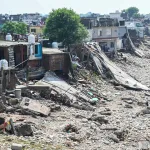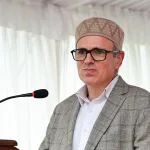The land mass bounded between latitude6 ͦ& 44´ / 35 ͦ degrees & 30´ North and longitude 68 ͦ& 7´/ 97 ͦ& 25´ East has the unique geographical bounties bestowed upon it by nature that guards its northern frontiers by way of an incessant maze of snowcapped mountains called as Himalayas with its southern, eastern and western extremities washed by the oceanic waters. Known by the name of India and now Bharat, it was as if God almighty was keeping an ever vigilant eye on this land and protecting it from the marauding effects of rapacious alien culture in the form of these physical barriers.
A cursory look at the world physical relief map will make us realize that either it is by a quirk of fate or as mentioned above a divine providence that has made this country buffeted from unsavoury elements of time and tide with physical features on its national boundaries as its eternal sentinels. The unique geographical disposition of India sitting as it is at the cross roads of famous Chinese and Mesopotamian civilizations gave birth to its very own and indigenous human civilization i.e. the ‘Indus valley civilization from which it still draws its sustenance.
From times immemorial the country has not only been a repository of a very fine interplay of both the rulers and the ruled adhering to the tenets of democratic way of functioning but also a very set piece governance model with the likes of ‘Kautliya’ or ‘Chanayka’ at the top of this model in the role of a quintessential official advisor to his ruler Chandragupta Maurya. The governance treatise in the form of ‘Nitisashtra’ or ‘Arthsashtra’ as propounded by this intrepid advisor has its equal in the world only in the form of Art of war’ a creation by another master strategic advisor known by the name ‘Sun Tzu, a product of ancient Chinese civilization.
With the country all decked up and spruced to celebrate its 75th anniversary of republic day, it is time to ask a fundamental question —- what are those unique qualities that have been seeped into the sinews of this sub-continent to sustain and showcase to the world at large year after year as a champion of democratic values and be a republic to boot? Surrounded amidst a host of theocratic, despotic and communist bloc countries why haven’t any of these disparate ideologies rubbed onto India so as to make it cross over to these neighboring nation’s ideology and be one among them? The reasons are many.
The idea of a nation state that India sustains within itself with moderation observed in its governance despite religious and cultural dichotomies has its genesis in the form of a multitude of faiths which grew from its soil propagating an equanimity of human relations unbiased from adherence to a particular line of thought and action. Two of the biggest religions in the world i.e. Hinduism and Jainism have their origin in this sub-continent that are sub-sets of each other but went on to pursue an altogether different line of religious adherence without stepping on to each other’s toes. Similarly the animist religion, Bon that is still actively followed in Tibet too has its path having a reflection of Buddhism in its tenets. On top of it the main protagonists of both Hinduism as well as Buddhism in the past i.e. AdiShankaryaacharya, Gautam Buddha and Emperor Ashoka to name a few went out of their mandate to propagate national integration and compassion which are the hallmarks of Indian democratic values.
This country doesn’t have to go far and wide to seek a noble way of governing its masses. It is all given in the ancient treatises that have been folklores, only to be passed on to the new progenies tinged with a flavor of today’s realpolitik. A span of 75 years in the democratic journey of a country is relatively a small spec in the overall timeline of its existence. Relatively nascent as compared to the centuries old democracy of US or that of UK, the Indian governance model has at its core a mix of tolerance, and an all-encompassing attitude which were bequeathed by the ruling classes to their masses even during the days of Maharajas and kings.
India is one of those rare countries which withstood relentless foreign attacks from centuries, only to bounce back to its original and pristine shape unaffected by the temporary foisting of foreign thinking and religion. There are cases in our ancient past when Maharajas and kings had alternative plans ,routes and locations chalked out in advance to protect their ancient scriptures, temples , sculptures, etc to be transported post haste from falling into foreign hands ;only to be brought back to their original locations when turbulence abated.
The ruling class saw themselves as a living extension of God incarnation bestowed with the onerous responsibility of dispensing away with justice and governance as would have been the case with God himself undertaking the same task. This essence of governance is not to be found in any of the democracies of the world, and hence India’s place in the democratic hue differs substantially from other democratic dispensations.
The adoption of Indian constitution on 26th January 1950 has been a seminal indication of its all organs of state governance coming through the ages honed on the anvil of hard work and professionalism. The impartial nature of our various courts impervious to extraneous pulls and pressures thus upholding the essence of equality of law in the eyes of the masses has been the bedrock of our republic. Be it the verdict on Triple Talaq, Ram janambhoomi, or the Kesavnanda Bharti case that upheld the powers to which a parliament could restrict property rights in pursuit of land reforms and the redistribution of large land holdings to cultivators, our constitution has stood the test of times and been a guiding light to the country often acting as a fulcrum on which could rest all the 3 pillars of a democracy i.e. Judiciary, legislature and the executive.
What more testimonies could a nation offer that despite having a population of 1.4 billion strong, it was one of the first few countries to roll out the much wanted vaccines for the world during the pandemic of corona where even the advanced nations of the west were looking askance? Slated to become the 3rd largest economy of the world and removing the ignominy of ‘Ship to mouth existence’ of the mid 1960s, India truly has been a republic since it removed the yoke of British rule. Time we acknowledged it with a sense of pride in this 75th year of our republic day.
(The writer is a retired army officer and can be approached on his email: slalotra [email protected])





